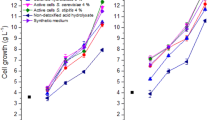Abstract
A total monosaccharide concentration of 37.8 g/L and 85.9% conversion from total fermentable monosaccharides of 44.0 g/L from 110 g dw/L Eucheuma denticulatum slurry were obtained by thermal acid hydrolysis and enzymatic saccharification. Subsequent adsorption treatment to remove 5-hydroxymethylfurfural (5-HMF) using 5% activated carbon and an adsorption time of 10 min were used to prevent a prolonged lag phase, reduced cell growth, and low ethanol production. The equilibrium adsorption capacity (q e) of HMF (58.183 mg/g) showed high affinity to activated carbon comparing to those of galactose (2.466 mg/g) and glucose (2.474 mg/g). The efficiency of cell growth and ethanol production with activated carbon treatment was higher than that without activated carbon treatment. Fermentation using S. stipitis KCTC7228 produced a cell concentration of 3.58 g dw/L with Y X/S of 0.107, and an ethanol concentration of 15.8 g/L with Y P/S of 0.48 in 96 h.




Similar content being viewed by others
References
Adams JM, Gallagher JA, Donnison IS (2009) Fermentation study on Saccharina latissima for bioethanol production considering variable pre-treatment. J Appl Phycol 21:569–574
Beer LL, Boyd ES, Peters JW, Posewitz MC (2009) Engineering algae for biohydrogen and biofuel production. Curr Opin Biotechnol 20:264–271
Teo CL, Atta M, Bukhari A, Taisir M, Yusuf AM, Idris A (2014) Enhancing growth and lipid production of marine microalgae for biodiesel production via the use of different LED wavelengths. Bioresour Technol 162:38–44
Naik SN, Goud VV, Rout PK, Dalai AK (2010) Production of first and second generation biofuels: a comprehensive review. Renew Sust Energ Rev 14:578–597
Goh CS, Lee KT (2010) A visionary and conceptual macroalgae-based third-generation bioethanol (TGB) biorefinery in Sabah, Malaysia as an underlay for renewable and sustainable development. Renew Sust Energ Rev 14:842–848
Palmqvist E, Hahn-Hägerdal B (2000) Fermentation of lignocellulosic hydrolysates. II: inhibitors and mechanisms of inhibition. Bioresour Technol 74:25–33
Carvalheiro F, Duarte LC, Lopes S, Parajó JC, Pereira H, Gírio FM (2005) Evaluation of the detoxification of brewery’s spent grain hydrolysate for xylitol production by Debaryomyces hansenii CCMI 941. Process Biochem 40:1215–1223
Ho YS, McKay G (1998) Sorption of dye from aqueous solution by peat. Chem Eng J 70:115–124
Sanchez-Machado DI, Lopez-Cervantes J, Paseiro-Losada P, Lopez-Hernandez J (2004) Fatty acids, total lipid, protein and ash contents of processed edible seaweeds. Food Chem 85:439–444
Mandels M, Andreotti R, Roche C (1976) Measurement of saccharifying cellulase. Biotechnol Bioeng Symp 6:21–23
Kubicek CP (1982) β-glucosidase excretion by Trichoderma pseudokoningii correlation with cell wall bound β-1,3-glucanase activities. Arch Microbiol 132:349–354
Kim IG, Rehman MSU, Han JI (2014a) Fermentable sugar recovery and adsorption potential of enzymatically hydrolyzed rice straw. J Clean Prod 66:555–561
Jol CN, Neiss TG, Penninkhof B, Rudolph B, De Ruiter GA (1999) A novel high-performance anion-exchange chromatographic method for the analysis of carrageenans and agars containing 3,6-anhydrogalactose. Anal Biochem 268:213–222
Kim DH, Lee SB, Jeong GT (2014b) Production of reducing sugar from Enteromorpha intestinalis by hydrothermal and enzymatic hydrolysis. Bioresour Technol 161:348–353
Meinita M, Kang JY, Jeong GT, Koo H, Park S, Hong YK (2012) Bioethanol production from the acid hydrolysate of the carrageenophyte Kappaphycus alvarezii (cottonii). J Appl Phycol 24:857–862
Ahn DJ, Kim SK, Yun HS (2012) Optimization of pretreatment and saccharification for the production of bioethanol from water hyacinth by Saccharomyces cerevisiae. Bioprocess Biosyst Eng 35:35–41
Mussatto SI, Roberto IC (2001) Hydrolysate detoxification with activated charcoal for xylitol production by Candida guilliermondii. Biotechnol Lett 23:1681–1684
Carvalho GBM, Mussatto SI, Cândido EJ, Almeida e Silva JB (2006) Comparison of different procedures for the detoxification of Eucalyptus hemicellulosic hydrolyzate for use in fermentative processes. J Chem Technol Biotechnol 81:152–157
Lee JM, Venditti RA, Jameel H, Kenealy WR (2011) Detoxification of woody hydrolyzates with activated carbon for bioconversion to ethanol by the thermophilic anaerobic bacterium Thermoanaerobacterium saccharolyticum. Biomass Bioenergy 35:626–636
Plazas Tovar L, Wolf Maciel MR, Maciel Filho R (2014) Plug flow reactor model to analyse operating conditions on the dilute H2SO4-acid hydrolysis of sugarcane bagasse at high-solids loading. Chem Eng Trans 37:325–330
Plazinski W, Dziuba J, Rudzinski W (2013) Modeling of sorption kinetics: the pseudo-second order equation and the sorbate intraparticle diffusivity. Adsorption 19:1055–1064
Kim SR, Ha SJ, Wei N, Oh EJ, Jin YS (2012) Simultaneous co-fermentation of mixed sugars: a promising strategy for producing cellulosic ethanol. Trends Biotechnol 30:274–282
Taherzadeh MJ, Gustafsson L, Niklasson C, Liden G (2000) Physiological effects of 5-hydroxymethylfurfural on Saccharomyces cerevisiae. Appl Microbiol Biotechnol 53:701–708
Sunwoo IY, Ra CH, Jeong GT, Kim SK (2016) Evaluation of ethanol production and bioadsorption of heavy metals by various red seaweeds. Bioprocess Biosyst Eng 39:915–923
Russell JB, Cook GM (1995) Energetics of bacterial growth: balance of anabolic and catabolic reactions. Microbiol Rev 59:48–62
Acknowledgements
This research was supported by the Basic Science Research Program through the National Research Foundation of Korea (NRF) funded by the Ministry of Education (2013R1A1A2059095).
Author information
Authors and Affiliations
Corresponding author
Additional information
Chae Hun Ra and Min Ji Kim are co-first author (equal contributors).
Rights and permissions
About this article
Cite this article
Ra, C.H., Kim, M.J., Jeong, GT. et al. Efficient utilization of Eucheuma denticulatum hydrolysates using an activated carbon adsorption process for ethanol production in a 5-L fermentor. Bioprocess Biosyst Eng 40, 373–381 (2017). https://doi.org/10.1007/s00449-016-1705-7
Received:
Accepted:
Published:
Issue Date:
DOI: https://doi.org/10.1007/s00449-016-1705-7




